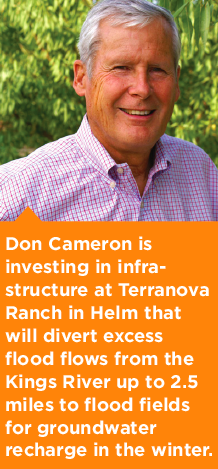 Almond grower Don Cameron of Terranova Ranch is investing in infrastructure to better use his farmland for groundwater recharge because he understands the importance of restoring them for the use of his own farm as well as the whole community around it.
Almond grower Don Cameron of Terranova Ranch is investing in infrastructure to better use his farmland for groundwater recharge because he understands the importance of restoring them for the use of his own farm as well as the whole community around it.
He and other growers were among the first to work with Sustainable Conservation, the nonprofit organization now partnered with Almond Board of California on a new project exploring the potential of using almond orchards for groundwater recharge. The project, in conjunction with ongoing UC Davis research, will use excess winter storm runoff to flood almond orchards, where water can then seep back into underground aquifers.
“With the new groundwater sustainability rules, we are not going to have a choice but to do something about the depletion of our aquifers,” Cameron said. Those rules include the 2014 Sustainable Groundwater Management Act, which will require the development of local agencies and plans for maintaining or improving underground aquifers in California sub-basins by 2017 and 2020, respectively.
Cameron has conducted multiple trials running excess winter flood flows onto sections of the farmland he manages at Terranova Ranch. Cameron is now part of a three-year project to build infrastructure with the potential of diverting excess surface water, mostly from winter flood flows, onto as much as 16,000 acres of cropland to recharge the groundwater basin for communities, farmers and the environment.
Terranova Ranch first experimented with groundwater recharge in 2010-2011 and has since expanded into tomatoes and vineyards. The sandy soil at Terranova Ranch is ideal for groundwater recharge, but this can’t be said for all farms.
“My neighbors thought I was crazy to have one-and-a-half feet of standing water in my vineyards from January to June, but I really didn’t see any long-term negative effects,” Cameron said.
On Cameron’s almond orchards that are drip-irrigated, a typical irrigation system for the almond industry, he will need to do some preparation in the orchard to accommodate flood water. This means building up small in-field berms to hold the flood water, so it can stand and percolate into the soil.
Unlike the crops with which Cameron has experimented before, there are questions about the suitability of almond orchards for recharge in terms of tree health. “There are definitely more issues with almonds than with grapes. And we will also have to watch the weather and avoid watering in advance of heavy winds so we don’t run the risk of the trees blowing over,” he added.
Throughout this winter season, ongoing technical research through the UC Davis Department of Plant Sciences will track soil moisture, water movement through the soil, and tree and root health and how those factors vary with local conditions in other complementary almond orchard trials. These trials will take place in Merced, Stanislaus and Fresno counties to determine where and how groundwater recharge can best take place in almonds.
